| Black Holes, Quarks, Hubble, Neutrinos, this would
have sounded like a foreign language back in
1951 when a small group of people with a common interest and a vision of the
future met at the Central Library with a view to forming an astronomical
society for Wolverhampton. It was at that meeting that the Wolverhampton Astronomical Society was
inaugurated and the society has been meeting regularly ever since and has
witnessed and, indeed, followed, the tremendous advancement in the science
of Astronomy.
In 1951 the idea of the exploration of space was the science fiction of
the day but even in those early days the Society was envisaging and
forecasting big strides forward in Astronomy and in October 1957 with the
launch of the Soviet satellite Sputnik 1 that first step was taken and some
members of the society have been observing and monitoring satellites ever
since. The moon landing was the next big
milestone; a prime example of how rapid technology was developing.
Such events always tended to increase membership of the
Society.
At the time there was, and still is, a lot of criticism of the amount of
money that space exploration costs, and whether or not the money would be
better spent but there are very many aspects of our present day life
especially, in the field of medical science that are a direct result of
space research. A major aspect is the need to get an awful lot in a small
space and this gives rise to heart pacemakers, keyhole surgery to name just
two.
Like most other societies funding was, and still is, a major problem.
Wolverhampton Astronomical Society, being totally self funding, it is always
difficult to balance the subscriptions to offset the running costs and the
major item of expense has always been that of hiring rooms in which to hold
the meetings. Hence in the 50 years we have moved a few times. In its early
days the Society meeting were held at various locations such as school rooms
and at one stage we met in Wulfruna Street in what was then called the
Technical College (now University) but the bell-ringers' practice night at
St Peter’s Church caused problems - but of course the Church was there
before the Society.
The Society then met at 38 Tettenhall Road in the mid 1960s and was there
for some years and we have now been at our present venue: Beckminster
Methodist Church Hall, Birches Barn Road for a considerable number of years.
But in the interim meetings had been held at Old Hill, Tettenhall and
Springfield Road.
|
|
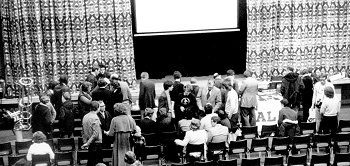
Getting ready for a public meeting. |
In the late 1960s the price of an
astronomical telescope was quite high and quite often out of the
price range of most amateurs and so the answer was to build the
structure yourself from whatever scrap was available.
You then had to consider the optics, and
these were very expensive. |
| A mirror, 8
inches in diameter and about 1 inch thick and made from low expansion glass
such as Pyrex, could be purchased at a cost of about £500, which of course
in the 1960s was a lot of money. After that you still had to consider the
secondary mirror and eyepieces, all of which added to the cost.
So not only did amateurs of the day construct the hardware, they also
tackled mirror grinding, that is, taking suitable blank Pyrex discs and
grinding out a concave in one to very accurate measurements, sometimes to a
thousandth of an inch. Several members of the Society did this and
constructed very effective instruments.
Telescope tubes could be made with
electrical conduit tubing and a series of pram wheels to make an open
skeleton tube to house the optics, just one of the many varied designs for
telescopes. Pram wheels were quite an effective solution but, whilst the
Society did not resort to hi-jacking prams, we did buy over 50 wheels from a
Black Country manufacturer of prams, because they were rejects, maybe the
chrome had not taken other some other fault. But that did not concern the
telescope builder. |
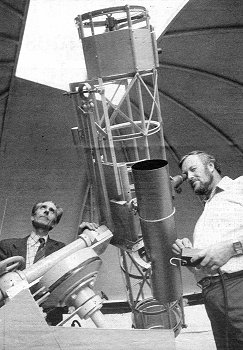
Malcolm Astley (left) and David Harris (right) with
their home made telescope. |

Sunspots, June 10 1979, 15h 18m GMT, taken by a member. |
However as time went on technology started to overtake and astronomical
telescopes, made by specialist companies, started to become cheaper and
people's disposable income started to increase. The art of telescope making
has receded somewhat.
Today telescopes have become very sophisticated and
instruments with computer controlled systems that enable the observer to
locate any object in the night sky by simply keying in the known
co-ordinates, Right Ascension and Declination, are well within the range of
the serious amateur. |
| Such telescopes need, of course, an observatory, even though that may be
in your own garden. But it is impractical to simply take the instrument
outside for view, it has to be carefully aligned and this can only be
achieved in an observatory. A Society observatory is quite another thing. Various attempts have been made by the Society to try to come up with a
solution but the cost is totally prohibitive. Such an observatory would have
to be sited away from light pollution. This is a problem in itself as it
means being out of town but still accessible to members. The cost of land,
either to purchase or lease, together with planning permission, electrical
supply, water supply, security fencing etc. etc., the requirements and costs
become almost endless. And when one looks at the number of clear nights
suitable for observing it would probably be underused.
The idea of renovating existing structures has been considered in the
past. One was at The Cedars, Compton Road, which was at one time the home of
the Butler family (of local brewing fame). There are the remains of an
observatory there, but again no funds were available from any source.
|
| In 1952 an approach was made to Lord Wrottesley of Wrottesley Hall, with
a view to trying to bring back into use a large observatory adjacent to the
Hall, but unfortunately it was in a bad a state of repair and really beyond
recovery. Wrottesley Hall is not within the Wolverhampton borough but, under
Section 34 of the Wolverhampton New Waterworks Act 1855, it was decreed if
any steam engine, furnace chimney or other apparatus generating, producing
or transmitting smoke was built by the waterworks company within three miles
of the observatory, it shall be constructed on the best and approved
principles "for burning and consuming the smoke arising or proceeding
therefrom". |
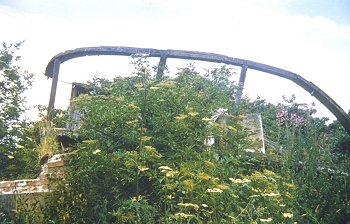
The ruins of the observatory at Wrotteseley Hall,
photographed in 1961. The ruins are in the grounds of the estate near
The Foaming Jug. |
| This of course was so that observations
from the observatory would not be hampered by smoke pollution. John (later Lord) Wrottesley was born in 1798 and became a founder member
of the Royal Astronomical Society and he did an enormous amount of
observational work at his first Observatory in Blackheath, London. He
recorded over 12,000 observations and in 1839 was awarded the RAS’s Gold
Medal Award. In 1841 his father died and John inherited the title and the
Staffordshire family estate at Wrottesley and he resolved to build an
observatory there - which he did - and again to take up serious astronomy.
The coordinates of the Observatory are 52 degrees 37 minutes 23 seconds
North and 2 Degrees 13 minutes 24 seconds West and are, of course, very
important for observational work. John Wrottesley died in 1867.
Brinsford Lodge, near Essington, was a hostel complex for overseas
students and prior to it being demolished we were able to have a room there
and did for a short while, have a large telescope installed.
In 1993 the Society hosted the first ever convention in Great Britain of
the International Union of Amateur Astronomers at the Compton Park Campus of
the Wolverhampton University when we attracted astronomers from all over the
world, including Japan, Australia, South Africa and many European countries.
A full week of events was arranged with professional astronomers giving
lectures and a special visit to Jodrell Bank was included. The Convention
was huge success and the Society received many congratulatory letters from
participants.
|
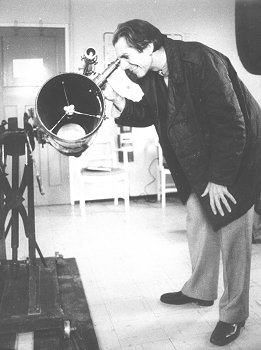
Malcolm Astley, then as for many years the Secretary,
checking the telescope. |
Astronomy is a science in which the amateur can still make a significant
contribution in certain fields and professional astronomers welcome the
amateur involvement.
Professional telescope time is very expensive indeed
and the professionals still rely to some extent on the amateurs, who
constantly patrol the skies, pursuing their favourite aspect of astronomy,
to alert them of anything unusual. |
The Wolverhampton Astronomical Society always welcomes new members and if
you wish to be part of an absorbing hobby and pastime then we are here to
help. Please contact the Assistant Secretary:
|
Philip Barnard, Assistant Secretary,
22
Leighton Road, Penn
WOLVERHAMPTON. WV4 4AR.
Telephone: 01902 342710. |
The Society also has a website at
www.wolvas.org.uk
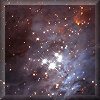
|
Return to the
previous page |
|

